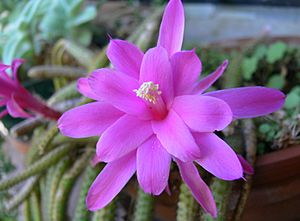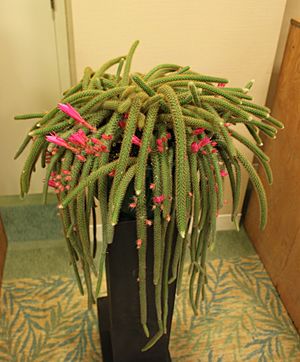Aporocactus flagelliformis facts for kids
Quick facts for kids Aporocactus flagelliformis |
|
|---|---|
 |
|
| Scientific classification | |
| Genus: |
Aporocactus
|
| Species: |
flagelliformis
|
| Synonyms | |
|
|
The Aporocactus flagelliformis, also known as the rattail cactus, is a type of flowering plant in the cactus family called Cactaceae. It's the most popular species grown from the Aporocactus group. People often grow it in pots because it's easy to care for and has beautiful flowers.
Contents
What Does It Look Like?
The rattail cactus has long stems that can grow up to 1 to 2 meters (about 3 to 6 feet) long. They start by growing upwards, then they hang down. These stems are about 8 to 24 millimeters thick. They have 7 to 14 rounded ridges.
The stems are covered in tiny, whitish spots called areoles. From these spots grow 8 to 20 bristle-like spines. These spines are usually yellowish to brownish and are 3 to 8 millimeters long. The plant's skin is green, but it turns grayish as it gets older.
Its Flowers
The flowers are quite striking! They are 7 to 10 centimeters (about 3 to 4 inches) long and 2 to 4 centimeters wide. They open during the day and stay open for 3 to 5 days. They don't have a scent. The flowers are bright crimson, which is a deep red color. Sometimes, the edges of the inner petals can be pink.
About Its Name
The scientific name Aporocactus flagelliformis has a special meaning. The word flagelliformis comes from Latin and means "shaped like a whip." This describes the plant's long, trailing stems. The common name "rattail cactus" also refers to these whip-like stems.
Why Its Name Changed
For a while, Aporocactus was considered a part of another group called Disocactus. But scientists looked closely at the plants' DNA. They found that Aporocactus is different enough to be its own separate group, or genus. So, the correct scientific name for this plant is now Aporocactus flagelliformis.
A Bit of History
The rattail cactus was one of the first cacti brought to Europe. It became popular around 1690, or maybe even earlier. It has always been a favorite plant for people to grow.
Where It Comes From
This cactus is native to Mexico, specifically in the state of Hidalgo. It grows in dry forests. You can find it growing on rocks (lithophytic) or on other plants (epiphytic) in these dry areas. It seems to be quite rare in the wild.
How to Grow It
Rattail cacti are very easy to grow, which is why they are so popular! You can grow them indoors in pots or in a greenhouse.
Care Tips
- Temperature: These plants need a minimum temperature of about 6°C (43°F).
- Light: They like bright light, but not direct sunlight.
- Soil: Use a rich potting mix. A good mix is four parts sandy loam with one part sand and crushed brick.
- Repotting: You should repot them every two years. This helps keep the soil fresh. You might not need a bigger pot, just fresh soil.
- Watering: From April to October, keep the soil moist. From November to March, water less often. Just give them enough water to keep the stems from drying out.
- Pruning: In winter, you can cut off any old or discolored stems at the base. This helps new stems grow.
This plant has even won an award! The Royal Horticultural Society gave it their Award of Garden Merit because it's such a great plant for gardens.
See also
 In Spanish: Disocactus flagelliformis para niños
In Spanish: Disocactus flagelliformis para niños


